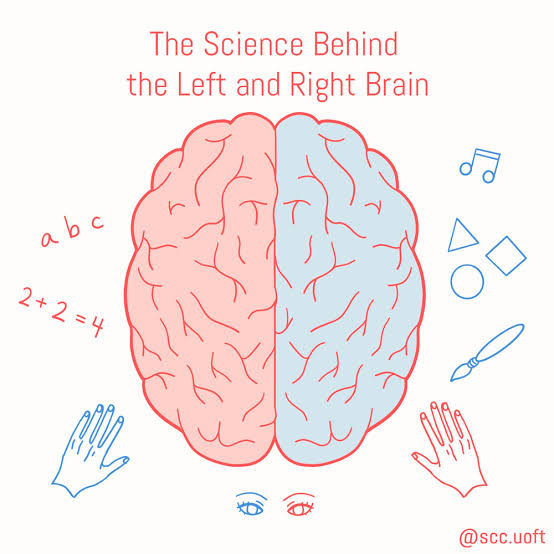My conscious experience is that I exist within a world with three dimensional objects around me which appears to be solid holographic images, within which I can move, touch and experience my reality. All of this takes place inside my head but is projected outside of my head and body, by my brain. I am able to walk up in one of these objects that I perceive in my head and touch it. The same applies to my somatosensory perceptions. If I cut my finger, this information is transferred to my brain which in turn relates that sensation back to where my finger is cut. I feel the pain in my finger, not my head. Somehow my brain is able to translate that sensation back to its origin. This is not a trivial matter. My brain has this extraordinary capacity to project the pain to where it came from. The same is true of other somatosensory processing, like touch, temperature and pressure, and all my other senses.
Holographic images are formed by two sources of information. I propose the the bifurcation of the brain into left and right hemispheres, is how we experience and perceive these abilities.
This 3 dimensional projection of what I see and feel are projected to be outside of my brain and body. These sensations are part of my conscious experience.
As most animals also have bilateral brains, they may also experience their reality in much the same way, using whatever senses are available to them. This may be part of their conscious experience as it is our own.
Our visual and somatosensory perceptions are processed in both the left and right hemispheres of our brains. The left field of my vision and somatosensory senses are largely processed by the right hemisphere, while the right field is processed by the left hemisphere. Each hemisphere also receives input from the other side of the brain through the Corpus Callosum (which are the huge bundle of fibres that connect the left and right hemispheres of the brain). Our holographic projections are generated by this bilaterification of the brain into left and right hemispheres. How?, I do not know. I imagine some sort on non-linear feedback mechanism is at play here. I have no idea who is observing these holographic projections either, but imagine that consciousness is also a feedback mechanism generated in much the same way. It is all an illusion. The question is what other sensations do I experience like this that also involve both halves of my brain?
Hearing is another sensation that is processed in both parts of my brain, as also are smell and taste. The auditory cortex, responsible for processing sound, is in both your left and right temporal lobes. Both sides of your brain process hearing, but each side has specialized roles. Generally, your left brain is more involved in understanding and producing speech, while your right brain is more dominant in processing pitch and the overall patterns of sound, such as in music. Signals from your right ear primarily go to the left side of your brain, and signals from your left ear go to the right side, but there’s also cross-communication between the hemispheres, as each is processing information.Olfaction (smell) and Gustation (taste), while often considered ipsilateral initially, higher-level processing and integration of these senses also involve bilateral brain regions.
Another neurological system that involves use of both the left and right hemispheres of the brain is balance. In the vestibular system (balance and spatial orientation), information from the inner ear’s balance organs contributes to processing in both hemispheres too. Proprioception (awareness of body position and movement) is also processed bilaterally in the brain and has a 3D out of body conception to it like the other sensations mentioned above.
The brain is also able to integrate ALL these sensations together in a unified way. For example, I can reach out to touch and object in my imaginary visual world and I will touch a said object at the same time as I feel this object, and experience that sensation. These are all conscious experiences that I perceive.
If my conjecture is correct, this offers a possible hint as to why my brain evolved to be is divided into two halves.
My next question is what other mammals and animals have their brain divided into 2 halves?
Brain bilateralization, where different hemispheres specialize in certain functions, is found in a wide range of animals, not just humans. This includes all other mammals, birds, dogs, cats, horses, fish, reptiles, and even insects, like bees, flies and ants.
This suggests that the bilaterification of the brain is a universally useful evolutionarily phenomenon, and that maybe all other such animals have a form of conscious experience.
Many animals do not have a brain divided into left and right hemispheres. This includes organisms with very simple nervous systems or no centralized brain at all, such as jellyfish, sponges, corals, starfish, and worms. I would suggest they are not conscious.
Even some animals with more complex nervous systems, like the octopus, do not have a bifurcated brain, but they have a central brain and 8 additional “brains” or ganglia in their arms, rather than a single, bilaterally hemispheric brain like mammals. An octopus which has nine brains, and is regarded as one of the most intelligent animals alive, besides humans.
Self-consciousness is the awareness that you are conscious. This is considered to be a higher level of consciousness. I believe that all animals with consciousness also have some level of self-consciousness, or a representation of themselves in relation to their perceived world as it is beneficial to their survival, although humans seem to have an extraordinary level of self-consciousness, that they can even go into their heads, think, plan, talk to themselves and enact complex reasoning.
Some other animals also have a high level of self-awareness and be able to think, examples of which include the orangutan, dolphin, and even the crow.
Even if the bilaterification of the brain is responsible for 3 dimensional sensations, the question of who is observing remains unanswered. This could also be an emergent property of the non-linear bootstrapping of the 2 brain hemispheres.
I believe that the self/mind is an illusion generated by the brain, for the brain, to give us the sensation of self-control for self preservation. I do not believe in “free will” per se, but in the ability to stop some thoughts from becoming actions. The neuron activity of a thought needs to proceed BEFORE a thought is made. The experiments of Libet et al confirms this1). They asked a girl to raise her arm when she wanted to. Researchers were able to determine when she would about 0.5 seconds before she was even aware to have made the decision, by detecting a readiness potential in her frontal cortex. My view is the self is really just an illusion too or model within our brains. That illusion is perpetuated in humans by humans. In childhood we assign the actions of a child with their name/identity. This exaggerates the notion of self/mind.
Lastly, I would like to tell you about what I observed with ants one day. I saw an ant fall into an ant lion’s nest. As the ant tried to climb up the hole the ant lion had made at the angle of repose, it must have sent put a signal that it was in trouble. Next, I saw 5 ants form a linked chain that descended into the ant lion’s hole. They managed to grab the ant that had had fallen in and drag him out, but as they were completing their rescue, another ant (from the rescue chain) fell inside the ant lion’s nest, so they all reformed a chain and saved him too. This makes me think that ants have a form of consciousness, whereby they are aware of their surrounding and make decisions accordingly, just like humans.
References
- Libet, B., Gleason, C. A., Wright, E. W., & Pearl, D. K. (1983). Time of conscious intention to act in relation to onset of cerebral activity (readiness-potential). Brain, 106(3), 623-642.


2 responses to “Does the bilaterification of the brain allow humans to perceive a three dimensional holographic worldview?: Are ants also conscious?”
[…] Does the bilaterification of the brain allow humans to perceive a three dimensional holographic worl… […]
[…] Does the bilaterification of the brain allow humans to perceive a three dimensional holographic worl… […]